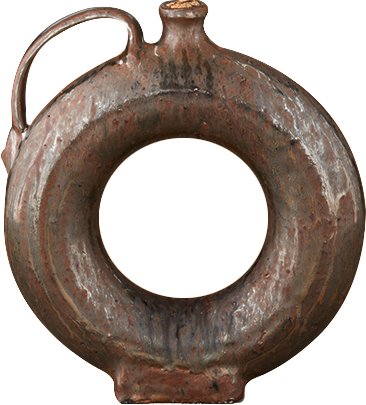




More than just an amazing example of southern pottery, this unusual stoneware bottle is linked to a broader story of healing and ceremonial traditions among African diasporic communities throughout the world. The bottom of this vessel is inscribed “Dr. Peter/Davis/1888,” which indicates that the potter John Stork made it specially for him. Born into slavery in 1812, Dr. Peter Davis of Columbia, South Carolina, became one of the only African American medical physicians of the time and a respected practitioner of Rootwork.
As was common at the time, Dr. Davis used the sacred symbols, signs, and substances of root medicine to address the needs of his community. Rootwork is derived from African traditions that were passed down, despite the effort of Christian missionaries and the medical establishment to suppress it, to the descendants of diasporic Africans residing in the Americas. To this day, Rootwork centers around African spiritual and supernatural practices that serve as a form of protection and control. Hoodoo, Voodoo (or Vodun), and other West African inspired religious and ceremonial practices often involved the leadership of shaman priests who performed acts of healing, spirit possession, coordination to the physical and spiritual self, ancestor reverence, meditation, and cleansing. These Rootwork practices required expert knowledge and included the use of dead men’s powder, graveyard dirt, whiskey, lodestones, roots, and herbs, just to name a few.
Because Rootwork and Hoodoo were at odds with enslavers’ medical and religious tenets, Dr. Davis and his peers often kept their healing practices secret. We only know of Dr. Davis’s Rootwork because he was sued by a Dutch immigrant farmer who claimed to have paid the doctor to use Rootwork to protect his farm, only to have his crops fail and cows fall sick. One fascinating detail about this trial is that the local sheriff was held in contempt of court for repeatedly releasing Dr. Davis; whether his refusal to hold the man in jail was out of respect for his medical or Rootwork practice is unknown. Just as this legal documentation offers only glimpses of a practice with deep and pervasive presence in the South, Dr. Peter Davis’s ring bottle could be analyzed as an object that contained a hidden meaning. Ring bottles are thought to have been inspired by early “Pilgrim” bottles that were first produced in ancient Rome and later made across the Islamic world. But their symbolism in the 1800s South remains mysterious. Did Dr. Davis use this unusual bottle, marked with not only his name but also his professional title, to carry and minister root medicine? If so, this rare and precious bottle held distinctly African diasporic spiritual symbolism.




